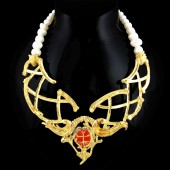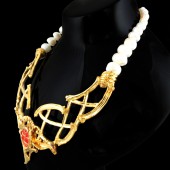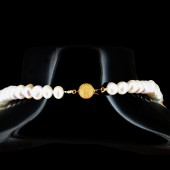Fishing Net Necklace Neck Piece by Lydia Marisa Siu |
Home > Winners > #43217 |
| CLIENT/STUDIO/BRAND DETAILS | |
 |
NAME: Lydia Marisa Ltd. PROFILE: Lydia’s jewellery takes inspiration from the Rococo period and reflects the fusion of Western and Eastern cultures, as well as the juxtaposition of the old and the new. All these elements combined create visually remarkable pieces in Lydia’s collections, and reflects her passion for craftsmanship with each individual piece. Born in USA and raised in Hong Kong, Lydia’s designs echo her own multi-cultural upbringing and the exotic integration of grandiose Eastern and Western concepts and ideologies. Working with the likes of the internationally renowned Vivienne Westwood and Stephen Webster, the London-based jewellery designer heralded for its cutting edge and remarkable designs, Lydia's career flourished. After receiving many critically acclaimed awards, which catapulted Lydia as an emerging designer in the jewellery industry, Lydia established her own brand and began the creation of opulent and challenging jewellery for the future which can be seen in Lydia's collections. Lydia graduated from the MA Design: Jewellery at Central Saint Martins College of Arts and Design, and is Gemological Institute of America (GIA) qualified in Graduate Color Stones and Pearl Grading. Working with the likes of the internationally renowned Vivienne Westwood and Stephen Webster, the London-based jewellery designer heralded for its cutting edge and remarkable designs, Lydia's career flourished. After receiving many critically acclaimed awards, which catapulted Lydia as an emerging designer in the jewellery industry, Lydia established her own brand and began the creation of opulent and challenging jewellery for the future which can be seen in Lydia's collections. Lydia graduated from the MA Design: Jewellery at Central Saint Martins College of Arts and Design, and is Gemological Institute of America (GIA) qualified in Graduate Color Stones and Pearl Grading. |
| AWARD DETAILS | |
 |
Fishing Net Necklace Neck Piece by Lydia Marisa Siu is Winner in Jewelry Design Category, 2015 - 2016.· Read the interview with designer Lydia Marisa Siu for design Fishing Net Necklace here.· Press Members: Login or Register to request an exclusive interview with Lydia Marisa Siu. · Click here to register inorder to view the profile and other works by Lydia Marisa Siu. |
| SOCIAL |
| + Add to Likes / Favorites | Send to My Email | Comment | Testimonials | View Press-Release | Press Kit |
Did you like Lydia Marisa Siu's Jewelry Design?
You will most likely enjoy other award winning jewelry design as well.
Click here to view more Award Winning Jewelry Design.








